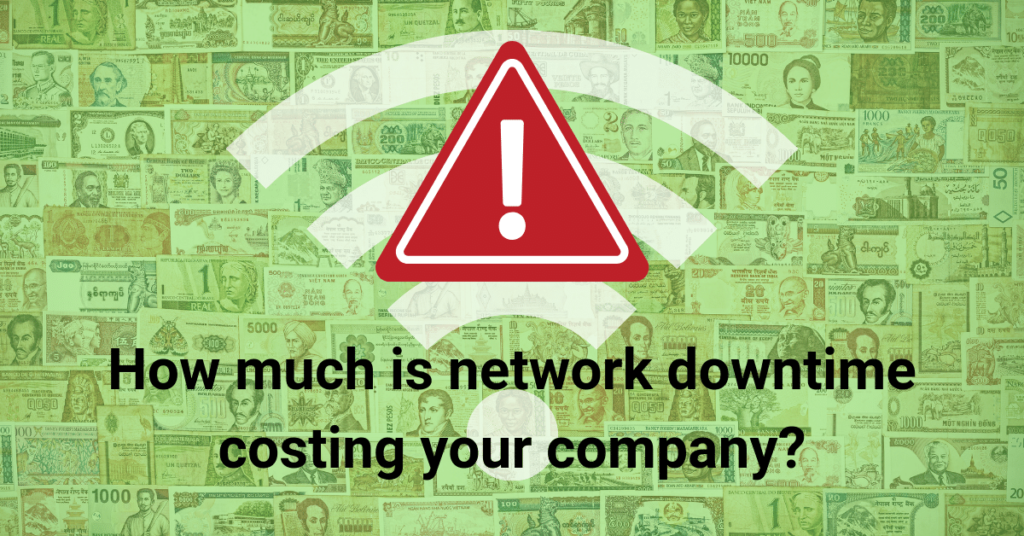Network Downtime: Costly across all industries.
Whether in the hospitality, healthcare, tech, education, oil and gas or the finance industry, NetBeez’ prospects and customers all have a similar problem: they are looking for a way to monitor their vast network infrastructure. Although being an Account Manager at NetBeez lends me to hear this similar problem many times each day, each company’s network infrastructure can be very complicated and unique. The many SaaS applications, multiple, remote, and global offices, cloud environments, and tech-savvy remote users can be an intimidating feat. These complex networks have IT today still trying to figure out how to manage all these tools and users.

Today, the problems, issues, and outages that occur across the network and network applications are often caught after the fact. Unfortunately, network engineers rely on user complaints, such as, “the network stinks”, or “Salesforce is slow”, or “Google won’t load” to gain insight into their network. That’s when IT starts troubleshooting, with limited objective data to find the root cause of the problem; many times only to find that their troubleshooting isn’t successful.
How to calculate your cost of downtime.
For both IT and the company, these user issues are more than just an inconvenience for all parties involved. These network and application outages cost the business money, and a lot of it. According to a study done by Gartner, the average cost of network downtime is $5,600 per minute. That’s over $300,000 per hour. Do you know how much network or application issues cost your company?
Here is a simple way to calculate how your business could be affected:
Cost of Downtime (per hour) = Lost Revenue + Lost Productivity + Recovery Costs + Intangible Costs
In order to determine ‘Lost Revenue’, you need to calculate the amount of revenue generated per hour by your business. Simply take ‘revenue per week’ and divide it by 40 hours. Next, you’ll need to factor in downtime (in hours) and uptime (%).
For example: If your company’s revenue is $5,000/hour and your network was down for 2 hours with an uptime percentage of 30%, your lost revenue would equal $3,000/hour. That’s a lot of money to be losing due to a network issue that could have been pinpointed and fixed in 15 minutes.
Next, you’ll have to account for ‘Lost Productivity’. Your employees are still being paid regardless of whether they’re able to perform their jobs or not. To calculate Lost Productivity, first determine each employee’s hourly salary. Then you’ll have to estimate the percentage of employee productivity, which is dependent upon uptime, also known as, ‘Utilization Percentage’.
So, in the above model, Lost Productivity ($412.50/hour) = Hourly Employee Salary ($27.50/hour) x Utilization Percentage (30%) x number of employees (50).
Recovery Costs are essentially the costs that are accrued while troubleshooting or resolving the issue, such as repair services, replacement parts, lost data recovery, etc. These aren’t quite as tangible as revenue and productivity costs, but they are important when determining your true cost of downtime.
Intangible Costs
Lastly, before adding up all of these costs, you’ll want to determine the Intangible Costs. These are present when network or application downtime affects your reputation or your brand. While these can be quite difficult to calculate, as they can affect your business in the long-term, it gives your business a better understanding of the impact that can occur due to downtime.
An example of Intangible Costs lost is Facebook’s recent outage in March. In TSG’s article, it is stated that Facebook may have lost up to $80,000,000 due to its 14 hour downtime.
Once you’ve calculated each separate cost, you can finally put them together into the main formula provided above and see your total cost of downtime. In our theoretical example I’m going to leave out Recovery and Intangible Costs, which still leaves us with a cost of downtime equaling $3,412.50/hour.
Prove that “It’s NOT the network.”
There are a lot of components in network infrastructures today, so issues can arise in many different areas. Monitoring and measuring these extensive networks can be a very daunting task. But, failing to gain that visibility into your network and application performance is a very costly mistake. That’s where NetBeez come in to play. Our network performance monitoring and visibility into the end-user’s experience helps you find the root cause of issues and proactively address these issues before your users are complaining. And in some cases, it gives you the objective data needed to prove to your users that “It’s NOT the network”!





